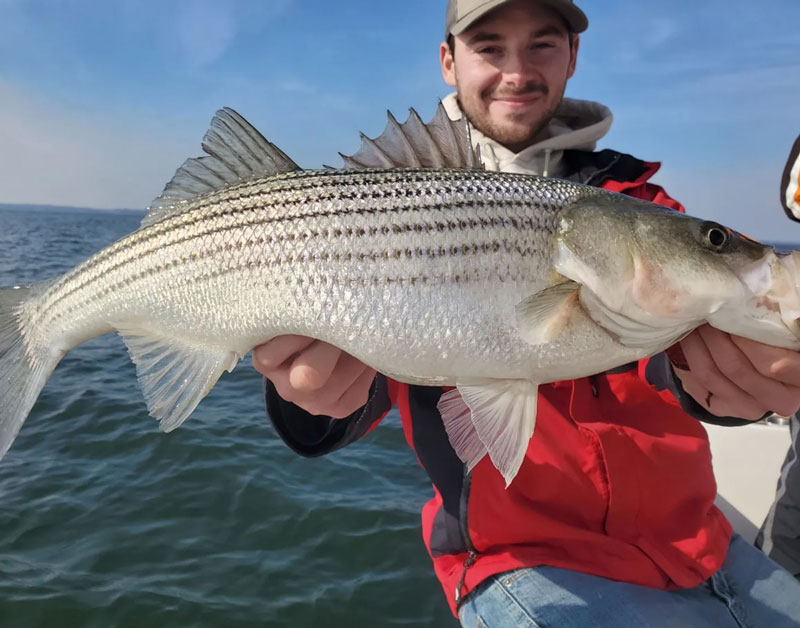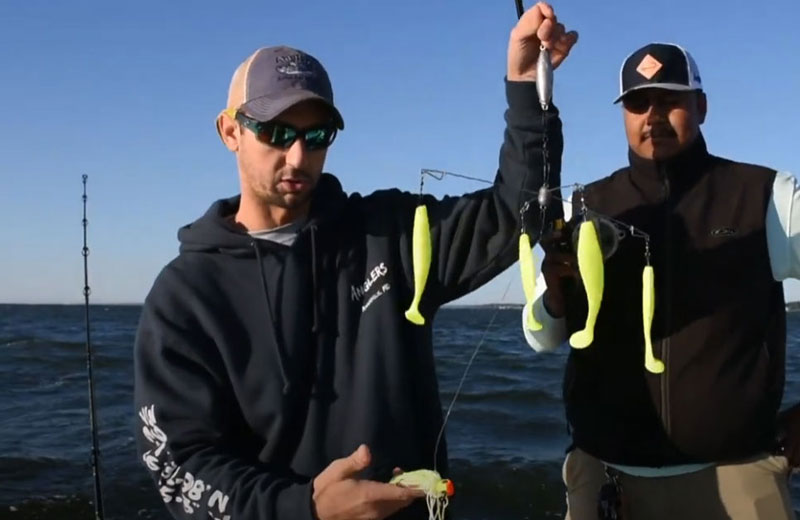Ah, November—striped bass are feeding hard to fatten up for winter, bite-windows are extended well past dawn and dusk, and bird shows are a distinct possibility. Much as we hate to think of the season soon drawing to a close, we love the often-epic action that cranks up before winter hits and the inevitable shutdown arrives.

This is the time of year when rockfish push out into open water and school up to chase bunker as they exit the tributaries. And this is also a time of year when trolling in the open Bay is a top tactic for filling the cooler.
Fall Striper Trolling Speed
Slow and steady wins this race; as a general rule of thumb most of the time two to 3.5 or maybe four mph is all you’ll want to be doing. For some boats that will mean trolling at idle speed and for others, putting just a slight tap on the throttle. Either way, while your speed should usually fall in this range don’t set your pace by staring at the GPS and picking a number.
Remember, your speed over ground and speed through the water will differ depending on the currents. While the GPS may confirm that your boat is traveling at three knots, if you’re headed into the current your lures may be swimming at four knots or more. Or if the current’s running the other way, they could be swimming at less than two. A more effective method of judging speed is simply to look at your lures. Lower them down next to the boat, keep your rod tip low, and give them a hairy eyeball. If those spoons are spinning wildly pull the throttle back. If they’re barely wiggling kick it up a notch. Then check your speed to make sure it falls within reasonable parameters and match it whenever you’re going in the same direction. When you make a significant change in direction remember that you may need to make a change in speed to keep the lures swimming at the same pace, and also bear in mind that as time goes on and the tide changes, the currents your lures are swimming with or against will change, too. Also note that in most areas of the Bay you can mitigate the effects of current to a large degree by trolling in an east-west pattern, rather than going north-south.
Best Lures for Fall Stripers

The vast majority of the lures being towed through the Bay at this time of year will be parachutes and Mojos tied into tandems, and umbrellas trimmed with six-inch shad usually in white or chartreuse, weighted down with six to 14 ounces of lead. There’s no denying the effectiveness of these offerings, and they certainly do belong in every troller’s arsenal. In fact, they should make up the bulk of the spread the bulk of the time. Some anglers pull nothing but these two offerings, but there are a few other choice picks that can trigger bites when the old standbys don’t do the trick.
Surgical hoses should always be kept on hand (red and green are often the ticket). Some seasons they won’t produce much but for whatever reason, other seasons the fish seem to prefer them. They can be run behind a planer or with an inline cigar weight from eight to 14 ounces. Try setting one out a time or two and if it gets hits add another to the spread. If not, pack it away.
Spoonbrellas are another offering that often produces, and there will be days when a spoonbrella out-catches the umbrellas. And if some larger fish have been around and you want to have a shot at catching and releasing a big over-slot fish add a #19 or #21 Tony Acetta Pet (now branded a Luhr-Jensen Pet) or a large Crippled Alewife run behind a cigar weight into the mix. (Note: don’t try rigging these large wobbling spoons behind a planer, because they have so much action they’ll trip it).
Choosing Where to Troll
Naturally, a critical element to success is that you troll where there are some fish. Unless you can go fishing four or five times a week the very best way to keep in tune with where those fish have been in the Chesapeake Bay is to check out the FishTalk Fishing Reports. Every season is different, but some areas that are regular late fall producers you’ll want to keep an eye out for include the Love Point and Belvidere Shoals zones in the Upper Bay; the mouth of Eastern Bay and the Choptank, the edges off North and Chesapeake Beach, and off Taylor’s Island in the Middle Bay; and in the mouth of the Potomac and the Rappahannock in the Lower Bay.
Use channel edges and drop-offs as a starting point and be sure to keep an eye on the fishfinder for bait. Areas where those big schools of bunker have gathered up are often where the rockfish will be, and unless fish are thrashing on the surface there’s no better indication that you’re in the hot zone.